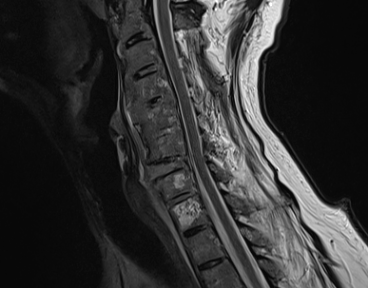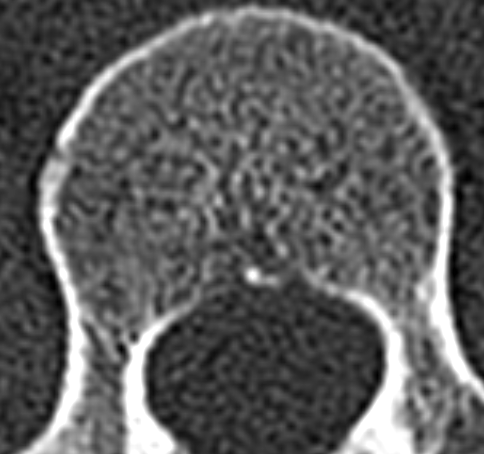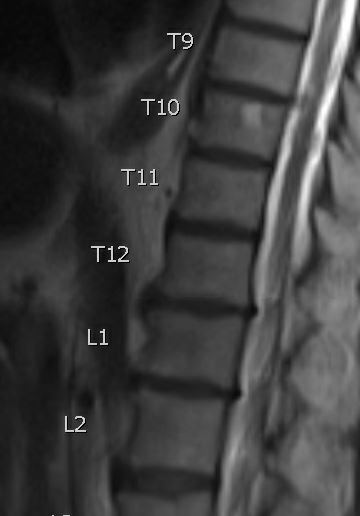[1]
Ciftdemir M, Kaya M, Selcuk E, Yalniz E. Tumors of the spine. World journal of orthopedics. 2016 Feb 18:7(2):109-16. doi: 10.5312/wjo.v7.i2.109. Epub 2016 Feb 18
[PubMed PMID: 26925382]
[2]
Nair AP, Kumar R, Srivastav AK, Sahu RN, Kumar B. Outcome of dorsolumbar vertebral hemangiomas presenting with neuraxial compression. Indian journal of orthopaedics. 2012 Sep:46(5):536-41. doi: 10.4103/0019-5413.101033. Epub
[PubMed PMID: 23162146]
[3]
Pastushyn AI, Slin'ko EI, Mirzoyeva GM. Vertebral hemangiomas: diagnosis, management, natural history and clinicopathological correlates in 86 patients. Surgical neurology. 1998 Dec:50(6):535-47
[PubMed PMID: 9870814]
[4]
Dang L, Liu C, Yang SM, Jiang L, Liu ZJ, Liu XG, Yuan HS, Wei F, Yu M. Aggressive vertebral hemangioma of the thoracic spine without typical radiological appearance. European spine journal : official publication of the European Spine Society, the European Spinal Deformity Society, and the European Section of the Cervical Spine Research Society. 2012 Oct:21(10):1994-9. doi: 10.1007/s00586-012-2349-1. Epub 2012 Jun 26
[PubMed PMID: 22732826]
[5]
Nguyen JP, Djindjian M, Gaston A, Gherardi R, Benhaiem N, Caron JP, Poirier J. Vertebral hemangiomas presenting with neurologic symptoms. Surgical neurology. 1987 Apr:27(4):391-7
[PubMed PMID: 3824146]
[6]
Lakemeier S, Westhoff CC, Fuchs-Winkelmann S, Schofer MD. Osseous hemangioma of the seventh cervical vertebra with osteoid formation mimicking metastasis: a case report. Journal of medical case reports. 2009 Nov 2:3():92. doi: 10.1186/1752-1947-3-92. Epub 2009 Nov 2
[PubMed PMID: 19946508]
Level 3 (low-level) evidence
[7]
Vinay S, Khan SK, Braybrooke JR. Lumbar vertebral haemangioma causing pathological fracture, epidural haemorrhage, and cord compression: a case report and review of literature. The journal of spinal cord medicine. 2011:34(3):335-9. doi: 10.1179/2045772311Y.0000000004. Epub
[PubMed PMID: 21756575]
Level 3 (low-level) evidence
[8]
Barzin M, Maleki I. Incidence of vertebral hemangioma on spinal magnetic resonance imaging in Northern Iran. Pakistan journal of biological sciences : PJBS. 2009 Mar 15:12(6):542-4
[PubMed PMID: 19580008]
[9]
Gray F, Gherardi R, Benhaiem-Sigaux N. [Vertebral hemangioma. Definition, limitations, anatomopathologic aspects]. Neuro-Chirurgie. 1989:35(5):267-9
[PubMed PMID: 2483579]
[10]
Jayakumar PN, Vasudev MK, Srikanth SG. Symptomatic vertebral haemangioma: endovascular treatment of 12 patients. Spinal cord. 1997 Sep:35(9):624-8
[PubMed PMID: 9300972]
[11]
Hao J, Hu Z. Percutaneous cement vertebroplasty in the treatment of symptomatic vertebral hemangiomas. Pain physician. 2012 Jan-Feb:15(1):43-9
[PubMed PMID: 22270737]
[12]
Doppman JL, Oldfield EH, Heiss JD. Symptomatic vertebral hemangiomas: treatment by means of direct intralesional injection of ethanol. Radiology. 2000 Feb:214(2):341-8
[PubMed PMID: 10671579]
[13]
Aich RK, Deb AR, Banerjee A, Karim R, Gupta P. Symptomatic vertebral hemangioma: treatment with radiotherapy. Journal of cancer research and therapeutics. 2010 Apr-Jun:6(2):199-203. doi: 10.4103/0973-1482.65248. Epub
[PubMed PMID: 20622368]
[14]
Dobran M, Mancini F, Nasi D, Gladi M, Sisti S, Scerrati M. Surgical treatment of aggressive vertebral hemangioma causing progressive paraparesis. Annals of medicine and surgery (2012). 2018 Jan:25():17-20. doi: 10.1016/j.amsu.2017.12.001. Epub 2017 Dec 8
[PubMed PMID: 29326813]



